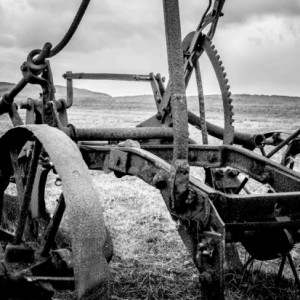Occupation
The book I have been reading about the archaeology of the Uists makes no mention of Orasaigh, nor does it feature in any of the walking guides we have seen. And yet this tiny grassy island, accessible at low tide across a sandy causeway,, has obviously been inhabited for thousands of years. You can see the lines of ancient field systems in the turf, and the marks of recent excations. It FEELs old, and sitting at the top of the hill, watching the light change over the hills of Barra, is a magical experience. We also watched a great skua drowning an oystercatcher in the sea below..
The bumpy track to the causeway passes a factory warehouse, which was open and empty of people, although obviously still used for storing and mending nets, so we went in to have a look. Old machinery and a broken glider spoke of past occupations and preoccupations.
Next to the island, a perfect white crescent of beach. At the end of it, by the outlet of a small river, were remnants of rope made from grass. We remembered a very moving play we had seen on another holiday, in Tiree, about Angus, Weaver of Grass, who had gone from South Uist to fight in the Second World War, and never recovered. He lived for many years in an institution and made amazing garments from grass. The museum at Kildonan has some of these on display but is currently closed for renovations. I have the book about his life at home.
My blip shows the “bent grass” and the extra some of the rusting farm machinery left on the machair, with Orasaigh and the factory in the background.
“Land of bent grass, land of barley,
Land where everything is plentiful, and
Where young men
Sing songs and drink ale”
from “Moladh Uibhist/In Praise of Uist” by Allan MacPhee


Comments
Sign in or get an account to comment.


